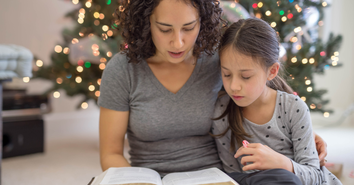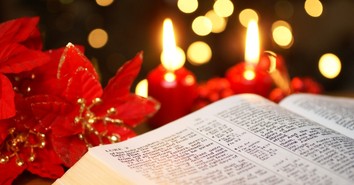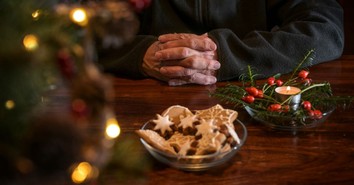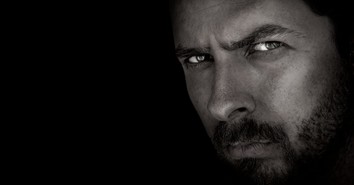Is it OK for My Child to Believe in the Easter Bunny?

When I was a little kid, I remember having scary dreams about a man-sized rabbit sneaking into my house the night before Easter Sunday.
I would think I saw him lurking in the hallway and peering into my room. It was terrifying. But, the fear would be washed away in the morning as I found a colorful Easter basket stuffed with that fake green grass and chocolates, bubble gum and small toys.
We’d get up early while it was still dark outside, to head out for the sunrise service at our church. My brother and I insisted on taking our Easter baskets with us, knowing there was a risk our chocolate would melt in the car.
The Easter Bunny, much like his counterparts Santa Claus and the Tooth Fairy, are difficult traditions to navigate as Christian parents.
On one hand, they can be harmless. Simply joyful experiences that produce lifelong memories. And, they provide tools for you to show your children how much they are loved and point them to Jesus, if used properly.
But, they can also cause a tremendous amount of conflict in the developing brain of a young child. Balancing what is real and what is not can be difficult to teach, and how we handle these traditions can aid in that process or be a detriment.
I understand that how you approach these traditions is very personal. Much like Santa and Christmas, it’s a big picture decision you should make with prayer and careful consideration. Each child is different, and how they respond to these cultural figures is unique as well.
As you consider how to handle the Easter Bunny, here are a few questions to ponder.
Where Did the Easter Bunny Come from, Anyway?
Today’s Easter traditions are complicated, and no one knows exactly how they came to be. Many believe that early Christians took over the pagan festivals celebrating Eastre, the goddess of springtime and fertility, and morphed them into celebrations that harmonized with Scripture.
Renowned fairy tale purveyor Jacob Grimm (Brothers Grimm), wrote in his 1835 book Deutsche Mythologie that “the Easter Hare is unintelligible to me, but probably the hare was the sacred animal of Ostara … Ostara, Eástre seems therefore to have been the divinity of the radiant dawn, of upspringing light, a spectacle that brings joy and blessing, whose meaning could be easily adapted by the resurrection-day of the Christian’s God.”
The Easter Bunny began his American tour in the 18th century, when German immigrants brought the custom with them when they settled in Pennsylvania. According to some sources, the German tradition involved “an egg-laying hare called “Osterhase” or “Oschter Haws.”
Their children made nests in which this creature could lay its colored eggs. Eventually, the custom spread across the U.S. and the fabled rabbit’s Easter morning deliveries expanded to include chocolate and other types of candy and gifts, while decorated baskets replaced nests. Additionally, children often left out carrots for the bunny in case he got hungry from all his hopping.”
Easter eggs themselves are said to be linked to pagan traditions celebrating springtime. However, some argue a more religious origin. Some believe Easter eggs can represent the resurrection, Jesus’s emergence from the tomb.
Decorating eggs is a tradition that dates back to at least the 13th century. Eggs were considered a forbidden food during Lent, so people would decorate them to mark the end of the period of fasting, and eat them on Easter as a celebration.
While it’s important to remember where traditions originate, it’s more important to consider how significant they are in your home. Where we devote our energy shows what we value most. Which brings us to the next question.
Do the Secular Easter Traditions Help Us Point Our Children to Christ?
It was a crisis of faith for my daughter that led us to reevaluate our priorities as it pertains to Santa Claus. She was struggling with doubts about God, but she had no trouble believing in Santa.
He seemed so real. He left presents for her, ate the cookies she left out and talked to her at the mall. That’s some pretty strong visual evidence for a young brain. When she said she wasn’t sure about God, all of a sudden, I felt like a failure as a parent.
My most important job is to point my children to Jesus. My goal should be to build the faith of my children, not grow their love for worldly traditions.
Is it wrong to take part in the secular traditions the holidays bring? Of course not. But, we should be careful about the fine line we walk in being truthful with our kids when they are old enough to understand. And, we should be careful about allowing secular trappings to take a more prominent place than they deserve.
We have fun during the holidays in our house. We give our children gifts on Christmas and Easter mornings. We enjoy many of the regular traditions at Easter – the egg hunts, dying Easter eggs, and of course, eating chocolate.
The Reese’s eggs are my favorite. There are a few goodies in Easter baskets for our children on Sunday morning, though we don’t really talk much about the Easter Bunny. He’s just not a big deal at our house.
Through it all, I often consider this verse from the Apostle Paul. “Everything is permissible, but not everything is beneficial. Everything is permissible but not everything builds up” (1 Corinthians 10:23). Some things we do are not about right or wrong, but rather are about helpful or not helpful.
I think that’s where the Easter Bunny tradition lands.
We need to think strategically about our holiday traditions. How can we use them to be beneficial and build up the faith of our children? With Santa, it’s a little easier to talk about the real story of St. Nicholas and why he gave children gifts. It’s an easy transition to then discuss the gift of Immanuel, God with Us.
If we’re being honest, it’s a much harder task to relate an oversized, gift-delivering bunny to the most important event in human history – the Resurrection. That begs the final question.
How Do You Balance Faith-Building and Joy-Robbing?
I’m not here to ruin Easter or rob your children of the joy and wonder of the holiday. The point of this article is not to be the springtime version of “The Grinch,” stealing away all the things that make our kids happy at Easter.
The point is to use the monumental celebration of Easter to show our children a different kind of joy--one that comes from knowing Christ and experiencing the “new life” he brings to each one of us who trust in Him.
Our Easter traditions can be used as a tool to point to Jesus’s resurrection. Many families use Resurrection Eggs to tell young children about the Easter story. Consider the other seasonal festivities.
As you dye Easter Eggs, talk to your children about Jesus’s resurrection. The egg itself has long been a symbol of new life and rebirth.
In addition, the process of taking a plain egg and dyeing it beautiful colors can symbolize how following Jesus makes you a new creation (2 Corinthians 5:17). Even plastic eggs loaded with goodies can be used to talk to your kids about the empty tomb and the significant gift we have in a risen savior.
But, what about the Easter Bunny? I wish I could tell you that – like Santa – there’s a great Christian tie-in for this Easter character. That would make it much easier to explain to our children. It’s just simply not true.
So, how you handle keeping Easter the fun and festive celebration it should be, while putting the Easter Bunny in his proper place is a personal decision for your family.
Many of today’s traditions have pagan roots, but I don’t believe it means we have to boycott our holiday celebrations. It just means we need to help our children understand what’s most important. At Easter, it is celebrating the Resurrection of Jesus Christ, not a Bunny who leaves a few chocolates in a basket.
Brent Rinehart is a public relations practitioner and freelance writer. He blogs about the amazing things parenting teaches us about life, work, faith and more at www.apparentstuff.com. You can also follow him on Twitter.
Photo Credit: ©Pixabay/castleguard
Originally published March 16, 2020.







